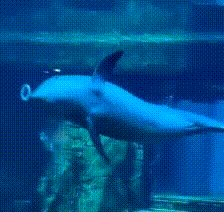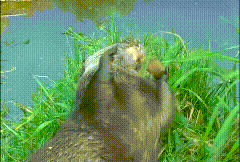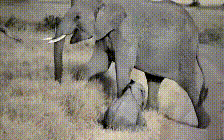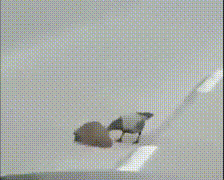ANIMAL IDENTITY AND LIFE EXPERIENCE
This page is mostly empathic guesswork – a necessary starting point.How do animals sense themselves. How do animals feel the question "what am I?"
How they sense their own body, is central to an animals survival and identity. Animals also often have a lifelong identity with a specific social group and territory.Their inner-body sense and their relationship with the world are experienced and understood by all of their physical senses and both the panoramic and focused use of these senses.
Basic Self-Identity
For warm-blooded animals, the sensation of warmth and all the sensory impressions inside their own bodies, are a very intimate sense of being. These feelings are far more conscious than the human subliminal inner-body awareness.Animals have a very intense awareness of the tastes inside their own bodies. Most animals only eat one type of food at a time. Simple foods leave clear residues which are easily integrated in the internal sense of taste.
Many animals know themselves and others by their scent, especially those leaving territorial markers.
Animals also identify and display socially with the sounds they make, (rather than with the abstract meaning of sounds, as humans do with words).
Sounds like the stomach rumbling and heart beating are felt far more intimately and actively by animals than humans. And animals with a high visual acuity would have a vivid imaginary picture of how they look inside.
These ideas may seem highly speculative, but apart from practising body awareness yourself with the senses, the only method of getting near to the truth would be to get a consensus of opinion from small children.
Those animals who lick themselves clean, have a very clear sense of how they and their siblings taste and smell from the outside.
Though i have no scientific evidence i imagine this is one very good reason why dogs don't like soapy baths: it destroys their self identity.
Smell and taste are stimulated and regulated by the lower brain. Animals are far more in touch with and reliant on their lower brain. This means they have a far greater direct connection with the autonomous functions of the body.
This active connection with the lower brain has a far deeper and greater significance than I can explain, experts in psychology would, or should know far more about this than I do.
Human vs. Animal Social Identity
Animal identity usually involves a lifelong relationship with the same land or sea territories, and often a deep unquestioned sense of belonging and social confirmation with their partners or social groups.These traits are to some extent evident among humans. However modern human social identification is far more diverse and often established on abstract levels of beliefs and ideas. (See Chapter 3 for more on this).
Humans also identify strongly with visual appearance. We regularly use mirrors and photographs. Animal identity is completely different. There are only around 10 animals who can recognise themselves in a mirror.
Animals have no choice about clothes or hairstyles, even chameleons and stick insects who disguise themselves don't do this for social recognition, they do it to remain incognito. Birds who visually display their hairstyles at mating times are exceptions. Such identity displays are discussed in depth in Display Rituals.
Animals' social identity is grounded in the same areas as their individual identity, in sounds and scents, taste, visual, and tactile reality. Animals are not involved in abstract thoughts about their social confirmation.
Play
Play seems to have little to do with identity. But the connections with social life, wanting pleasure and even developing attachments are worth considering.Groups of animals often play with each other. This is usually interpreted (maybe incorrectly) as a sort of instinctive training for practical and social life. However maybe they are just having fun, and experience 'wanting pleasure'.
 Crows, magpies, squirrels, racoons and many other animals play with things humans have left lying around. Give most animals a rubber ball and they will play.
Crows, magpies, squirrels, racoons and many other animals play with things humans have left lying around. Give most animals a rubber ball and they will play.
Beluga whales and dolphins blow bubbles and play with the rings.
Games with natural objects are rare. However one exception is otters juggling with stones.  The game must date back before human times.
The game must date back before human times.
Some otters build a long term attachment to their special stones. They carry their play stones in their pockets of loose skin under their arms. Play appears to be the first step any animal developed to forming identity through worldly attachments. (Display Rituals covers this in greater depth.)
There's also pleasure but maybe not real play, when the hippo and pig wallow in the mud bath, or the hen dust bathes in the sun – a forerunner of humans sunbathing or lying in the bathtub.
 Self-pity and Selflessness
Self-pity and Selflessness
Young elephants are among the animals who demonstrate self-pity with temper tantrums.
 Magpies and crows are remarkable for their acts of consideration and selflessness. A Crow sharing food with a mouse (1.20 mins.) is too long for me to show here.
Magpies and crows are remarkable for their acts of consideration and selflessness. A Crow sharing food with a mouse (1.20 mins.) is too long for me to show here.
The Two Modes of Sensing
Animals have two different pragmatic sensory systems for experiencing themselves and the outside world. Focusing and panoramic.And in the same way that how we sense the world determines how we understand it and ourselves – an animals' sensory abilities determines their understanding, their relationship with, and their feeling of identity in the world.
An animals experience of focusing must result in a feeling similar to ours – of being an active subject doing something to, with, or at, an object.
But the panorama mode is also fundamental to their survival. And this experience is a constant reminder of how it feels to stop thinking, be still inside, receptive, and directly connected with what they are sensing.
It's an habitual rut which animals have. So, whenever animals feel safe enough to doze – we can easily understand that they are far more practised than we are at turning off any form of thinking, and then sensing their bodies warmth and vitality directly with all of their physical senses.
And I believe it is this inner sense of self-sufficiency in their own bodies which sustains them, it gives them an underlying background sense of peace with themselves and the world. A sharp contrast to their daily fears of being eaten alive.
Both the abstract and concrete walls humans have around us, create a vastly different basis for identity and how it feels to be alive.
This openness, even nakedness, to an outside world without any walls; makes an enormous difference to a creature's sense of self and others, in terms of vulnerability, and also connectedness. Their ability to love and also to fear is understandably, very high.
I repeat, these explanations are mainly guesswork based on feeling empathy with animals, and this is the best we can do without a consensus of opinion from small children.
If you want to, you can compare the above viewpoint to Wikipedia: Animal Consciousness. I find scientific and objective sources miss the point. Please contact me if you have any other insights or interesting perspectives.
Support Pages
Mirrors
Display Rituals
Animal Rights in the Modern World
Please continue with Body and Breathing Awareness
Back to Chapter Seven : Creative Dozing
Back to THE PANORAMA SENSES Priority Pages